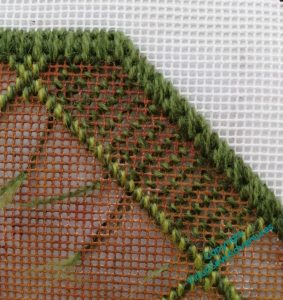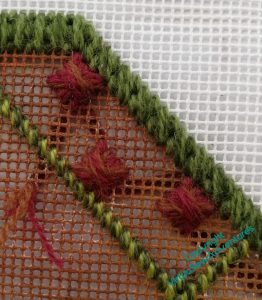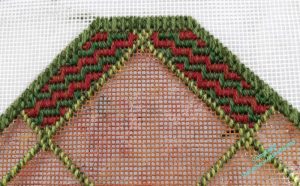Long Borders
There’s a good deal of trial and error with this one!
Once I’d divided up the long borders (both of them, so that it remains easy to keep track of) I started to experiment with stitches to fill in the various sections.
For a while I thought I might like to play with voiding some of the patterns, so I started with a sort of skip tent stitch. I wasn’t happy with that – it ended up combining stripes with a general appearance of not being there at all.
So, next trial – what about some large bosses, Diagonal Rhodes Stitch or something like that, which will be nicely reminiscent of the topiary experimentation that inspired the cushion?
I suppose this might have worked, maybe with a river of stitching in another colour to join the three diamonds, but when I looked at it in the context of the entire border, I wasn’t happy with it. Quite why, I’m not sure, but it felt like a false start. I’ve had quite a few of those with this project, and I’m beginning to recognise the sensation!
So, in the end, I settled for finding a smallish full coverage stitch, using vertical stitches like the borders, which isn’t on quite the same diagonal as the border edgings, but seems nevertheless to work. It’s called Victorian Step Stitch in Jo Ippolito Christensen’s book, and I’ve never seen it anywhere else (that goes for a lot of the stitches in that book!). A small advantage was that it mirrored relatively easily about the centre line, creating an arrowhead.




The skip tent stitch makes me think of rows of seedlings, so although it’s not right in your borders, may be worth filing away for use at another time.
The final result looks ideal for the job. Voiding canvas rarely works very well. The mesh is just too skinny to contribute its share. Tent/half-cross stitch is beefy enough, if boring.
Victorian Step stitch was a good find, works well. Always nice to find something different.
I will have to look for that book
Skipping stitches on canvas often means that the thread will be visible as it travels on the back. So filling the whole area is far better in my opinion. I find the Victorian Step Stitch very attractive and most suitable for the borders.
I think you ended up with a very nice stitch.
I like the final choice of stitch – it covers nicely and fits in well!
third time lucky 🙂 Good choice!